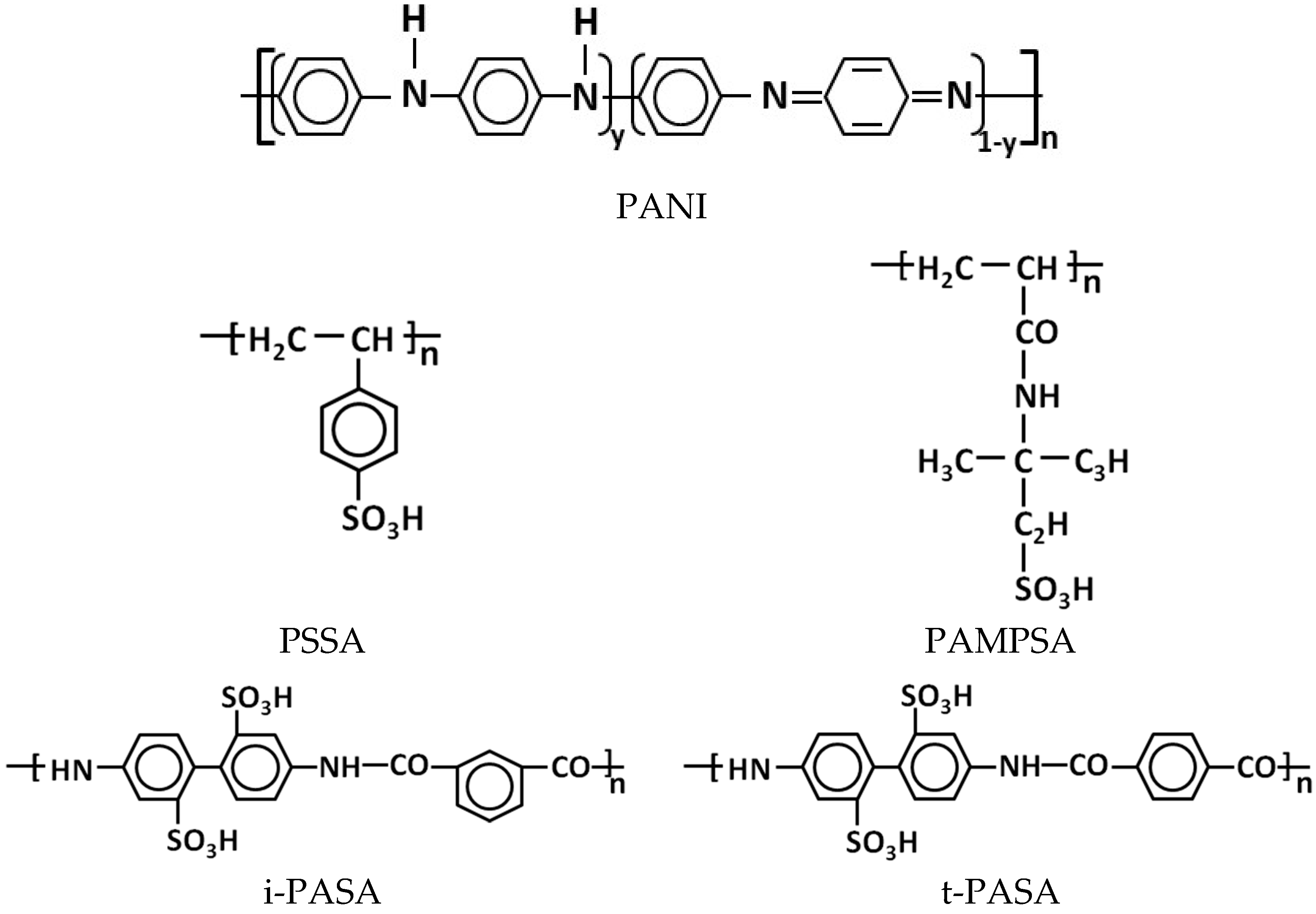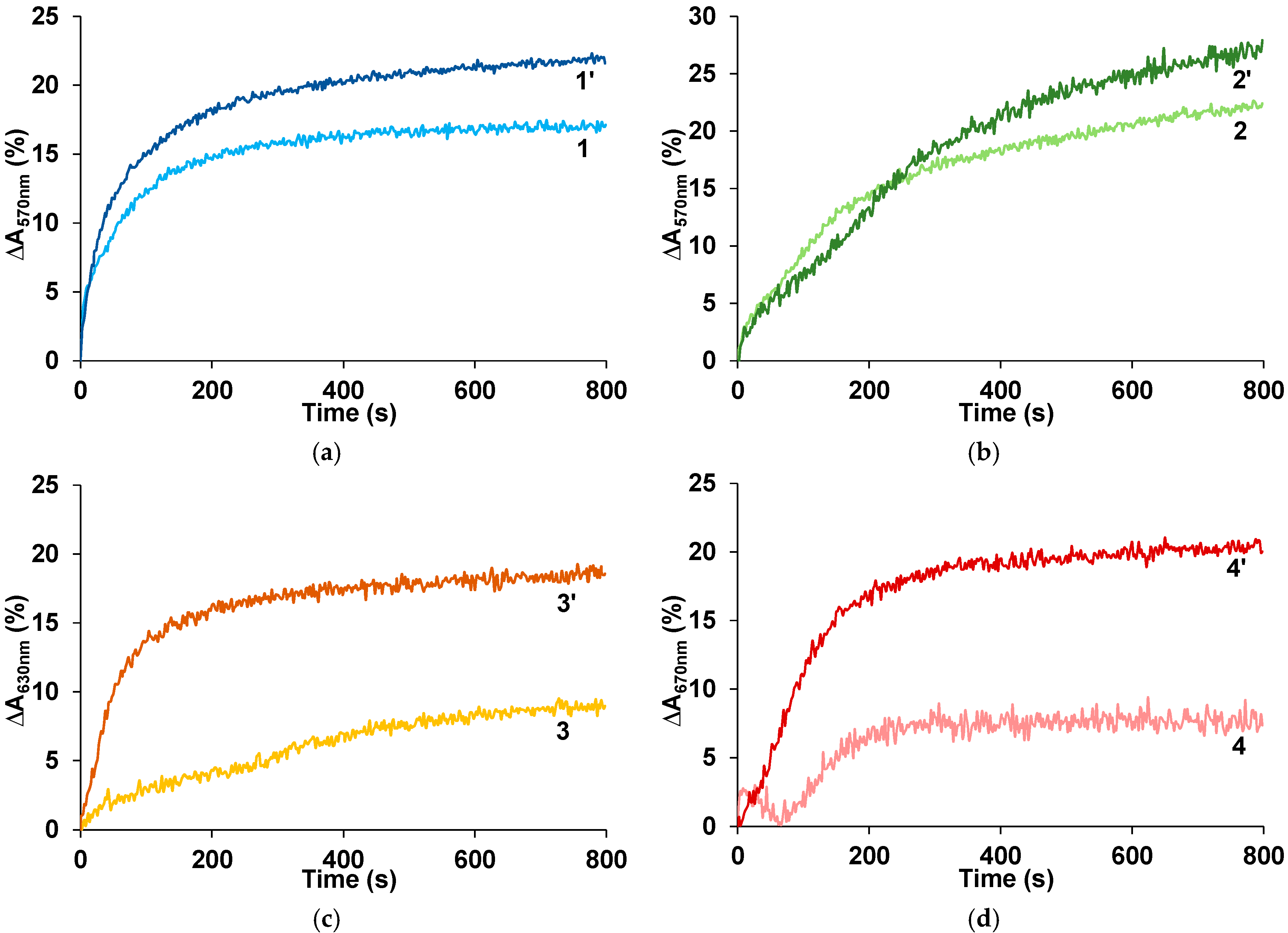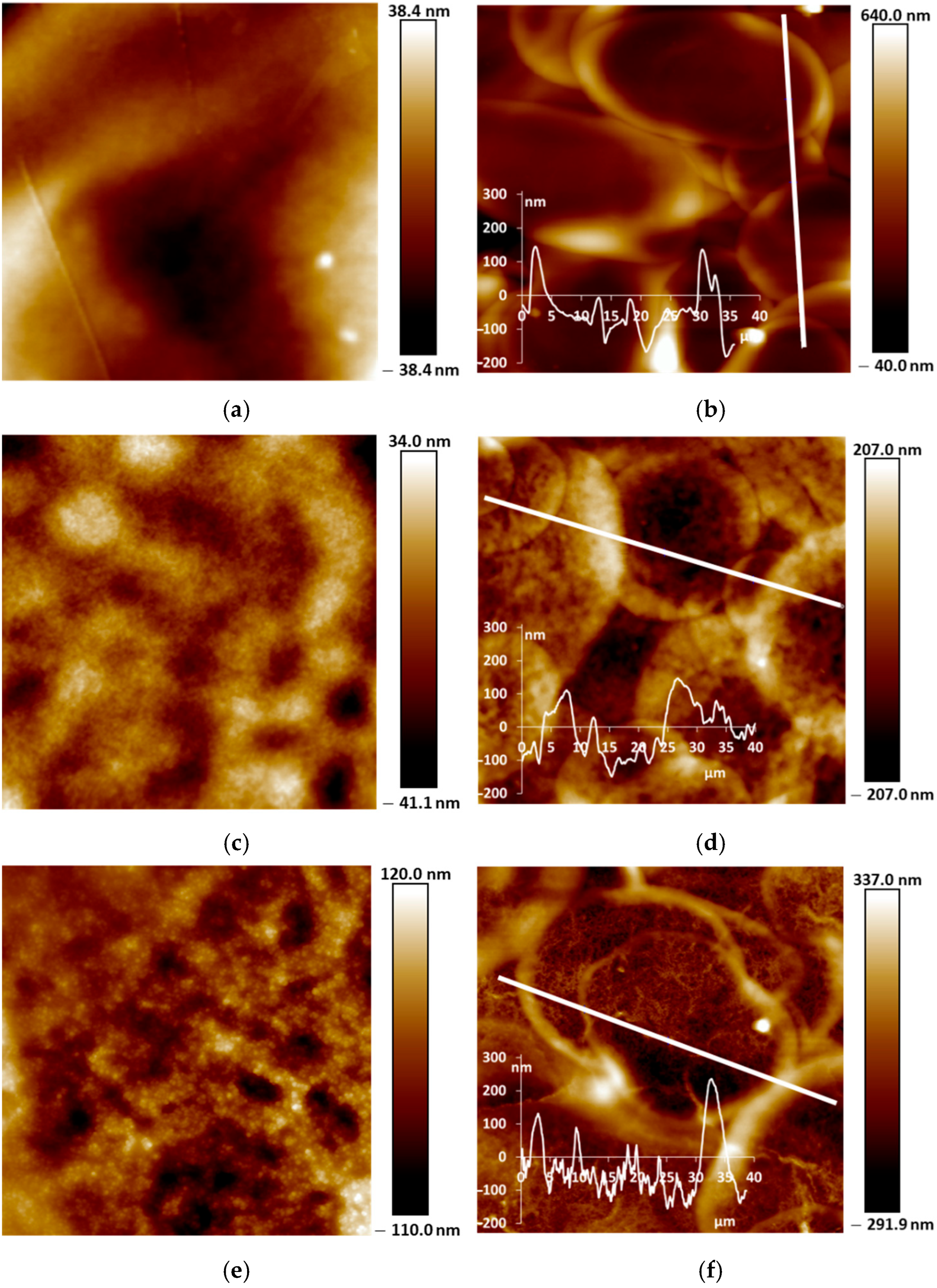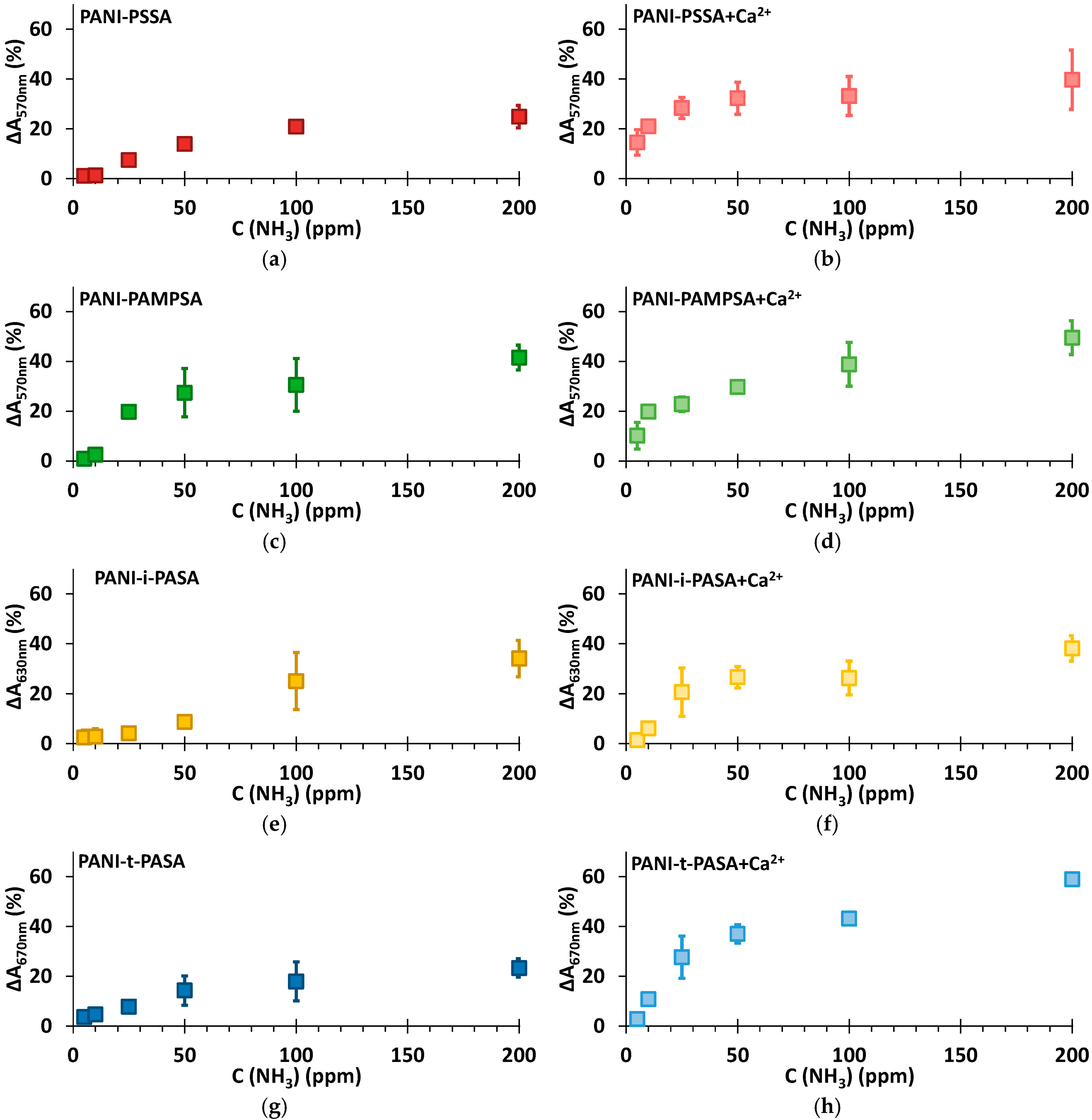Optical Ammonia Sensors Based on Spray-Coated Polyaniline Complexes with Polysulfonic Acids
Abstract
1. Introduction
2. Materials and Methods
2.1. Materials
2.2. Characterization Techniques
3. Results and Discussion
3.1. Spectral Changes in PANI Films During Exposition to Ammonia
3.2. Specific Features of Ammonia-Sensing Properties of PANI–Polyacids Films
3.3. Morphology
3.4. Sensing Properties
4. Conclusions
Supplementary Materials
Author Contributions
Funding
Institutional Review Board Statement
Informed Consent Statement
Data Availability Statement
Acknowledgments
Conflicts of Interest
References
- Bai, H.; Shi, G. Gas Sensors Based on Conducting Polymers. Sensors 2007, 7, 267–307. [Google Scholar] [CrossRef]
- Wong, Y.C.; Ang, B.C.; Haseeb, A.S.M.A.; Baharuddin, A.A.; Wong, Y.H. Review—Conducting Polymers as Chemiresistive Gas Sensing Materials: A Review. J. Electrochem. Soc. 2020, 167, 37503. [Google Scholar] [CrossRef]
- Lange, U.; Roznyatovskaya, N.V.; Mirsky, V.M. Conducting Polymers in Chemical Sensors and Arrays. Anal. Chim. Acta 2008, 614, 1–26. [Google Scholar] [CrossRef]
- Mishra, P.K.; Sharma, H.K.; Gupta, R.; Manglik, M.; Brajpuriya, R. A Critical Review on Recent Progress on Nanostructured Polyaniline (PANI) Based Sensors for Various Toxic Gases: Challenges, Applications, and Future Prospects. Microchem. J. 2025, 208, 112369. [Google Scholar] [CrossRef]
- Yumnam, M.; Hatiboruah, D.; Mishra, R.; Sathyaseelan, K.; Nath, P.; Mishra, P. A Smartphone-Based Optical Sensor with Polyaniline Label for Quantitative Determination of Freshness of Freshwater Fish Fillets. Sens. Actuators A Phys. 2023, 361, 114557. [Google Scholar] [CrossRef]
- Brannelly, N.T.; Killard, A.J. An Electrochemical Sensor Device for Measuring Blood Ammonia at the Point of Care. Talanta 2017, 167, 296–301. [Google Scholar] [CrossRef] [PubMed]
- Kim, S.; Lee, Y.-I.; Choi, Y.-M.; Lim, H.-R.; Lim, J.-H.; Myung, N.V.; Choa, Y.-H. Thermochemical Hydrogen Sensor Based on Chalcogenide Nanowire Arrays. Nanotechnology 2015, 26, 145503. [Google Scholar] [CrossRef]
- Huang, H.; Pan, Z.; Wang, J.; Wang, T.; Yang, W.; Yu, H.; Li, F.; Dong, X.; Yang, Y. Ag Nanoparticles Sensitized ZnO/MoS2 Composites to Detect Ppb-Level NO2 and Automobile Exhaust Gas. Sens. Actuators B Chem. 2025, 433, 137569. [Google Scholar] [CrossRef]
- Yang, W.; Huo, Y.; Wang, T.; Liu, X.; Li, D.; Yu, H.; Dong, X.; Yang, Y. RGO@In2O3 Based Flexible Gas Sensor: Efficient Monitoring of Trace NO2 Gas at Room Temperature. Sens. Actuators B Chem. 2025, 430, 137359. [Google Scholar] [CrossRef]
- Qiu, L.; Huo, Y.; Pan, Z.; Wang, T.; Yu, H.; Liu, X.; Tong, X.; Yang, Y. Resister-Type Sensors Based on Ti3C2Tx MXene Decorated In2O3 p-n Heterojunction for Ppb-Level NO2 Detection at Room Temperature. J. Environ. Chem. Eng. 2025, 13, 115249. [Google Scholar] [CrossRef]
- Ayad, M.M.; Torad, N.L. Quartz Crystal Microbalance Sensor for Detection of Aliphatic Amines Vapours. Sens. Actuators B Chem. 2010, 147, 481–487. [Google Scholar] [CrossRef]
- Gribkova, O.; Kabanova, V.; Tverskoy, V.; Nekrasov, A. Comparison of Optical Ammonia-Sensing Properties of Conducting Polymer Complexes with Polysulfonic Acids. Chemosensors 2021, 9, 206. [Google Scholar] [CrossRef]
- Yang, L.; Huang, H.; Zhou, Q.; Kan, Z.; Qi, Y.; Dong, B.; Song, H.; Ren, L.; Xu, L.; Yu, S.; et al. A Multimodal Sensing Network Based on Synergistically Sensitized Polyaniline Composites Strategy for Safety Monitoring in Pesticide Spraying. Sens. Actuators B Chem. 2024, 420, 136486. [Google Scholar] [CrossRef]
- Li, D.Y.; Liu, L.X.; Wang, Q.W.; Zhang, H.B.; Chen, W.; Yin, G.; Yu, Z.Z. Functional Polyaniline/MXene/Cotton Fabrics with Acid/Alkali-Responsive and Tunable Electromagnetic Interference Shielding Performances. ACS Appl. Mater. Interfaces 2022, 14, 12703–12712. [Google Scholar] [CrossRef]
- Kebiche, H.; Debarnot, D.; Merzouki, A.; Poncin-Epaillard, F.; Haddaoui, N. Relationship between Ammonia Sensing Properties of Polyaniline Nanostructures and Their Deposition and Synthesis Methods. Anal. Chim. Acta 2012, 737, 64–71. [Google Scholar] [CrossRef]
- Peřinka, N.; Držková, M.; Randjelović, D.V.; Bondavalli, P.; Hajná, M.; Bober, P.; Syrový, T.; Bonnassieaux, Y.; Stejskal, J. Characterization of Polyaniline-Based Ammonia Gas Sensors Prepared by Means of Spray Coating and Ink-Jet Printing. Sens. Lett. 2014, 12, 1620–1627. [Google Scholar] [CrossRef]
- Ismail, A.H.; Mohd Yahya, N.A.; Yaacob, M.H.; Mahdi, M.A.; Sulaiman, Y. Optical Ammonia Gas Sensor of Poly(3,4-Polyethylenedioxythiophene), Polyaniline and Polypyrrole: A Comparative Study. Synth. Met. 2020, 260, 116294. [Google Scholar] [CrossRef]
- Tsizh, B.; Aksimentyeva, O. Ways to Improve the Parameters of Optical Gas Sensors of Ammonia Based on Polyaniline. Sens. Actuators A Phys. 2020, 315, 112273. [Google Scholar] [CrossRef]
- Ismail, A.H.; Mohd Yahya, N.A.; Mahdi, M.A.; Yaacob, M.H.; Sulaiman, Y. Gasochromic Response of Optical Sensing Platform Integrated with Polyaniline and Poly(3,4-Ethylenedioxythiophene) Exposed to NH3 Gas. Polymer 2020, 192, 122313. [Google Scholar] [CrossRef]
- Mikhaylov, S.; Ogurtsov, N.; Noskov, Y.; Redon, N.; Coddeville, P.; Wojkiewicz, J.-L.; Pud, A. Ammonia/Amine Electronic Gas Sensors Based on Hybrid Polyaniline–TiO2 Nanocomposites. The Effects of Titania and the Surface Active Doping Acid. RSC Adv. 2015, 5, 20218–20226. [Google Scholar] [CrossRef]
- Li, L.; Ferng, L.; Wei, Y.; Yang, C.; Ji, H.-F. Effects of Acidity on the Size of Polyaniline-Poly(Sodium 4-Styrenesulfonate) Composite Particles and the Stability of Corresponding Colloids in Water. J. Colloid. Interface Sci. 2012, 381, 11–16. [Google Scholar] [CrossRef] [PubMed]
- Gribkova, O.L.; Nekrasov, A.A.; Trchova, M.; Ivanov, V.F.; Sazikov, V.I.; Razova, A.B.; Tverskoy, V.A.; Vannikov, A.V. Chemical Synthesis of Polyaniline in the Presence of Poly(Amidosulfonic Acids) with Different Rigidity of the Polymer Chain. Polymer 2011, 52, 2474–2484. [Google Scholar] [CrossRef]
- Sezen-Edmonds, M.; Loo, Y.L. Beyond Doping and Charge Balancing: How Polymer Acid Templates Impact the Properties of Conducting Polymer Complexes. J. Phys. Chem. Lett. 2017, 8, 4530–4539. [Google Scholar] [CrossRef] [PubMed]
- Kulkarni, M.V.; Apte, S.K.; Naik, S.D.; Ambekar, J.D.; Kale, B.B. Ink-Jet Printed Conducting Polyaniline Based Flexible Humidity Sensor. Sens. Actuators B Chem. 2013, 178, 140–143. [Google Scholar] [CrossRef]
- Crowley, K.; Smyth, M.; Killard, A.; Morrin, A. Printing Polyaniline for Sensor Applications. Chem. Pap. 2013, 67, 771–780. [Google Scholar] [CrossRef]
- Sarfraz, J.; Ihalainen, P.; Määttänen, A.; Peltonen, J.; Lindén, M. Printed Hydrogen Sulfide Gas Sensor on Paper Substrate Based on Polyaniline Composite. Thin Solid. Films 2013, 534, 621–628. [Google Scholar] [CrossRef]
- Ragazzini, I.; Gualandi, I.; D’Altri, G.; Di Matteo, V.; Yeasmin, L.; Cassani, M.C.; Scavetta, E.; Bernardi, E.; Ballarin, B. Polyaniline/Poly (2-Acrylamido-2-Methyl-1-Propanesulfonic Acid) Modified Cellulose as Promising Material for Sensors Design. Carbohydr. Polym. 2023, 316, 121079. [Google Scholar] [CrossRef]
- Kabanova, V.A.; Gribkova, O.L.; Pozin, S.I.; Tverskoy, V.A.; Nekrasov, A.A. Complexes of Polyaniline with Sulfonated Polysulfone. Their Structure and Sensory Properties. Prot. Met. Phys. Chem. Surf. 2024, 60, 148–157. [Google Scholar] [CrossRef]
- Gribkova, O.L.L.; Kabanova, V.A.A.; Nekrasov, A.A.A. Electrodeposition of Thin Films of Polypyrrole-Polyelectrolyte Complexes and Their Ammonia-Sensing Properties. J. Solid. State Electrochem. 2020, 24, 3091–3103. [Google Scholar] [CrossRef]
- Fujita, H.; Hao, M.; Takeoka, S.; Miyahara, Y.; Goda, T.; Fujie, T. Paper-Based Wearable Ammonia Gas Sensor Using Organic–Inorganic Composite PEDOT:PSS with Iron(III) Compounds. Adv. Mater. Technol. 2022, 7, 2101486. [Google Scholar] [CrossRef]
- Jost, V.; Reinelt, M. Effect of Ca2+ Induced Crosslinking on the Mechanical and Barrier Properties of Cast Alginate Films. J. Appl. Polym. Sci. 2018, 135, 45754. [Google Scholar] [CrossRef]
- Mikula, K.; Skrzypczak, D.; Ligas, B.; Witek-Krowiak, A. Preparation of Hydrogel Composites Using Ca2+ and Cu2+ Ions as Crosslinking Agents. SN Appl. Sci. 2019, 1, 643. [Google Scholar] [CrossRef]
- Silva, M.A.d.; Bierhalz, A.C.K.; Kieckbusch, T.G. Alginate and Pectin Composite Films Crosslinked with Ca2+ Ions: Effect of the Plasticizer Concentration. Carbohydr. Polym. 2009, 77, 736–742. [Google Scholar] [CrossRef]
- Gribkova, O.L.; Melnikova, E.I.; Teplonogova, M.A.; Tverskoy, V.A.; Nekrasov, A.A. Conductive Polyaniline-Based Composition for Spray Coating. Colloids Surf. A Physicochem. Eng. Asp. 2024, 692, 133903. [Google Scholar] [CrossRef]
- Kirsh, Y.E.; Fedotov, Y.A.; Iudina, N.A.; Artemov, D.Y.; Yanul’, N.A.; Nekrasova, T.N. Polyelectrolyte Properties of Sulphur-Containing Polyamides Based on Isophthalic and Terephthalic Acids in Aqueous Solutions. Polym. Sci. USSR 1991, 33, 1040–1047. [Google Scholar] [CrossRef]
- Kosandrovich, E.G.; Shachenkova, L.N.; Soldatov, V.S. Distribution of Ammonia, Mono-, Di- and Triethylamine in the Water Solution–Gas Phase System. Dokl. Natl. Acad. Sci. Belarus. 2019, 63, 164–168. [Google Scholar] [CrossRef]
- Nekrasov, A.A.; Ivanov, V.F.; Vannikov, A. Analysis of the Structure of Polyaniline Absorption Spectra Based on Spectroelectrochemical Data. J. Electroanal. Chem. 2000, 482, 11–17. [Google Scholar] [CrossRef]
- Stejskal, J.; Kratochvíl, P.; Radhakrishnan, N. Polyaniline Dispersions 2. UV—Vis Absorption Spectra. Synth. Met. 1993, 61, 225–231. [Google Scholar] [CrossRef]
- Health and Safety Executive. EH40/2005 Workplace Exposure Limits for Use with the Control of Substances, 4th ed.; TSO: Hobart, Australia, 2020; Volume 61. [Google Scholar]
- Timmer, B.; Olthuis, W.; Berg, A. van den Ammonia Sensors and Their Applications—A Review. Sens. Actuators B Chem. 2005, 107, 666–677. [Google Scholar] [CrossRef]
- Trchová, M.; Stejskal, J. Polyaniline: The Infrared Spectroscopy of Conducting Polymer Nanotubes (IUPAC Technical Report). Pure Appl. Chem. 2011, 83, 1803–1817. [Google Scholar] [CrossRef]
- Sun, L.; Liu, H.; Clark, R.; Yang, S.C. Double-Strand Polyaniline. Synth. Met. 1997, 84, 67–68. [Google Scholar] [CrossRef]









| ΔA at 50 ppm, % | tr, s (50 ppm) | D, 10−12, cm2/s | |
|---|---|---|---|
| PANI-PSSA | 10.3 | 171 | 2.5 |
| PANI-PSSA+Ca2+ | 22.5 | 66 | 7.9 |
| PANI-PAMPSA | 12.4 | 378 | 3.4 |
| PANI-PAMPSA+Ca2+ | 25.8 | 206 | 17.4 |
| PANI-i-PASA | 7.6 | 216 | 3.1 |
| PANI-i-PASA+Ca2+ | 21.8 | 115 | 9.2 |
| PANI-t-PASA | 17.7 | 142 | 25.2 |
| PANI-t-PASA+Ca2+ | 40.3 | 104 | 55.8 |
| Spray Coating | Electrodeposition | |||
|---|---|---|---|---|
| ΔA, % | tr, s | ΔA, % | tr, s | |
| PANI-PAMPSA | 25.8 | 206 | 18.0 | 70 |
| PANI-t-PASA | 40.7 | 104 | 19.7 | 194 |
Disclaimer/Publisher’s Note: The statements, opinions and data contained in all publications are solely those of the individual author(s) and contributor(s) and not of MDPI and/or the editor(s). MDPI and/or the editor(s) disclaim responsibility for any injury to people or property resulting from any ideas, methods, instructions or products referred to in the content. |
© 2025 by the authors. Licensee MDPI, Basel, Switzerland. This article is an open access article distributed under the terms and conditions of the Creative Commons Attribution (CC BY) license (https://creativecommons.org/licenses/by/4.0/).
Share and Cite
Gribkova, O.L.; Kabanova, V.A.; Rodina, E.I.; Teplonogova, M.A.; Demina, L.I.; Nekrasov, A.A. Optical Ammonia Sensors Based on Spray-Coated Polyaniline Complexes with Polysulfonic Acids. Sensors 2025, 25, 3348. https://doi.org/10.3390/s25113348
Gribkova OL, Kabanova VA, Rodina EI, Teplonogova MA, Demina LI, Nekrasov AA. Optical Ammonia Sensors Based on Spray-Coated Polyaniline Complexes with Polysulfonic Acids. Sensors. 2025; 25(11):3348. https://doi.org/10.3390/s25113348
Chicago/Turabian StyleGribkova, O. L., V. A. Kabanova, E. I. Rodina, M. A. Teplonogova, L. I. Demina, and A. A. Nekrasov. 2025. "Optical Ammonia Sensors Based on Spray-Coated Polyaniline Complexes with Polysulfonic Acids" Sensors 25, no. 11: 3348. https://doi.org/10.3390/s25113348
APA StyleGribkova, O. L., Kabanova, V. A., Rodina, E. I., Teplonogova, M. A., Demina, L. I., & Nekrasov, A. A. (2025). Optical Ammonia Sensors Based on Spray-Coated Polyaniline Complexes with Polysulfonic Acids. Sensors, 25(11), 3348. https://doi.org/10.3390/s25113348








